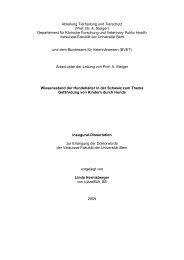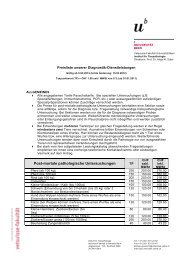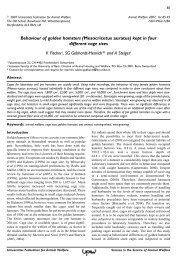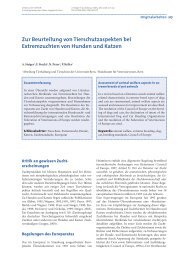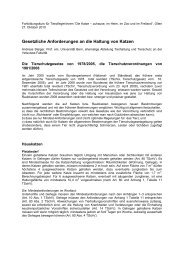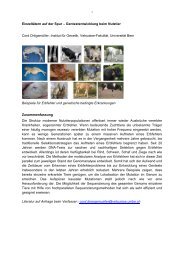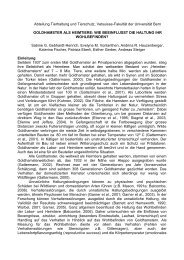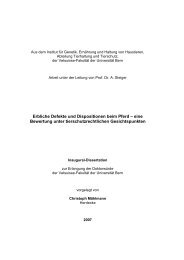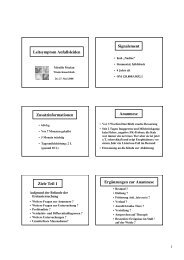Behaviour of golden hamsters (Mesocricetus auratus) - Vetsuisse ...
Behaviour of golden hamsters (Mesocricetus auratus) - Vetsuisse ...
Behaviour of golden hamsters (Mesocricetus auratus) - Vetsuisse ...
Create successful ePaper yourself
Turn your PDF publications into a flip-book with our unique Google optimized e-Paper software.
top wire. Some <strong>hamsters</strong> used to climb while pausing during wire gnawing. Theyusually climbed up and down the front side <strong>of</strong> the wire top but then returned to thesame point and restarted wire gnawing. Outside directed exploratory climbing wasconsidered as the behavioural source <strong>of</strong> stereotypic wire gnawing in laboratory mice(Würbel et al., 1996).All <strong>hamsters</strong> used the sand bath for grooming regularly, but not exclusively.Most <strong>hamsters</strong> used to wallow in the sand. Thus a sand bath seems very importantfor the welfare <strong>of</strong> <strong>golden</strong> <strong>hamsters</strong>, whether housed in small or big cages. Certainly itcan also be recommended for laboratory conditions as a reasonable enrichment,since the sand can be changed along with litter, if necessary.The available free space was used in all cage sizes. Hamsters in big cagesused the whole ground area and the observed duration which they spent in the openspace was longer. They used to walk particularly along the walls, so that trails wereformed. Staying near the walls (called thigmotaxis) is common in rodents and is usedas an index <strong>of</strong> anxiety (Simon et al., 1994, in mice). Some <strong>hamsters</strong> built a big crop<strong>of</strong> litter in the middle <strong>of</strong> the cage and formed a trail through the middle <strong>of</strong> it, which leddirectly from the running wheel to the house.Although there was more open space in the big cages and the distancesbetween the locations were longer, so that <strong>hamsters</strong> could run more, runningduration did not differ significantly among cage sizes. Possibly, <strong>hamsters</strong> in big cagesran faster, which led to a similar duration <strong>of</strong> running.The occurrence <strong>of</strong> thigmotaxis is no argument against big cages. Due to thefact that there were only two possibilities for covering, the house and the space underand behind the running wheel, the <strong>hamsters</strong> could have been afraid <strong>of</strong> running in theopen space. But big cages can be enriched more than small cages, so that morepossibilities for covering can be given. Additionally more enrichment may lead to less24



